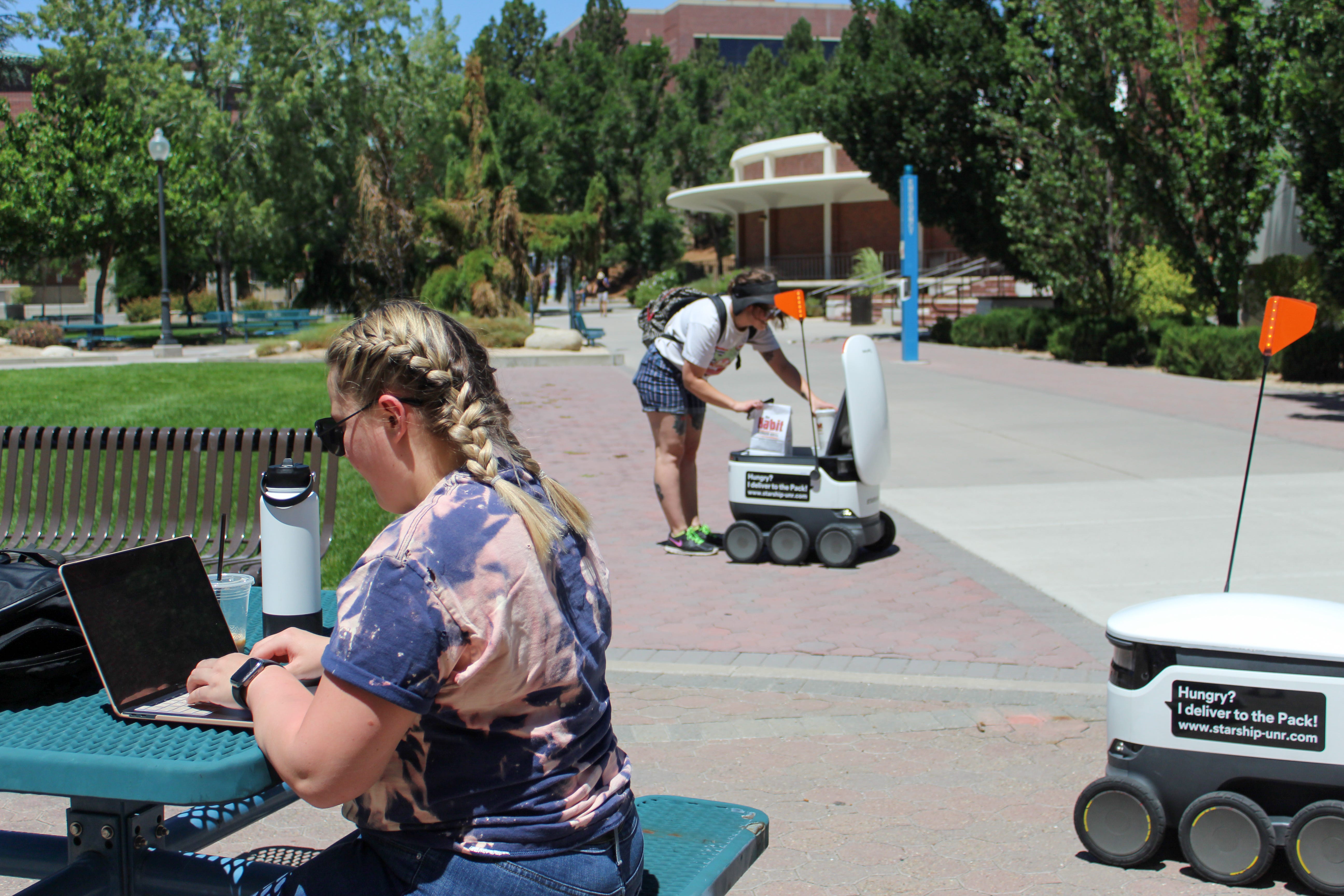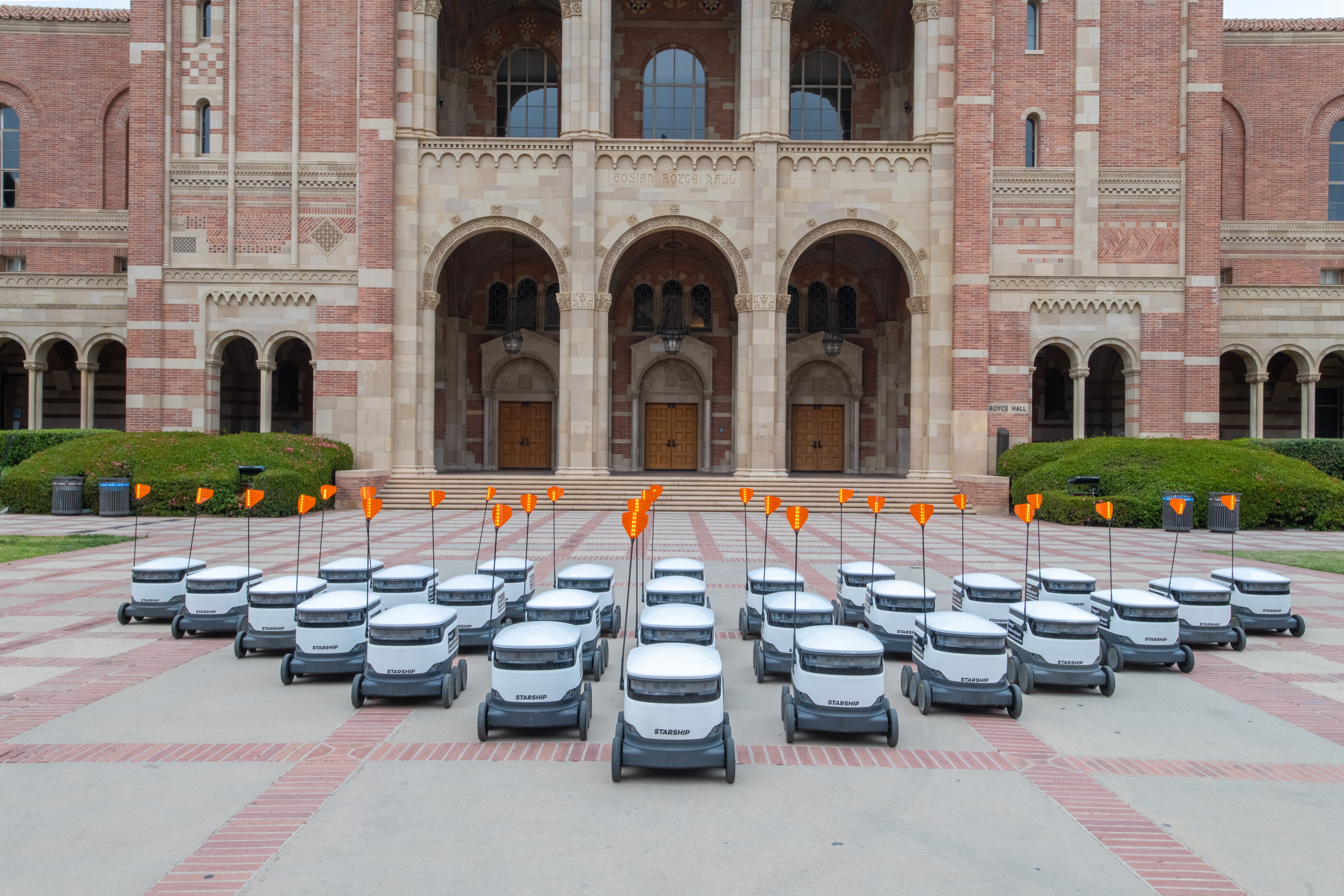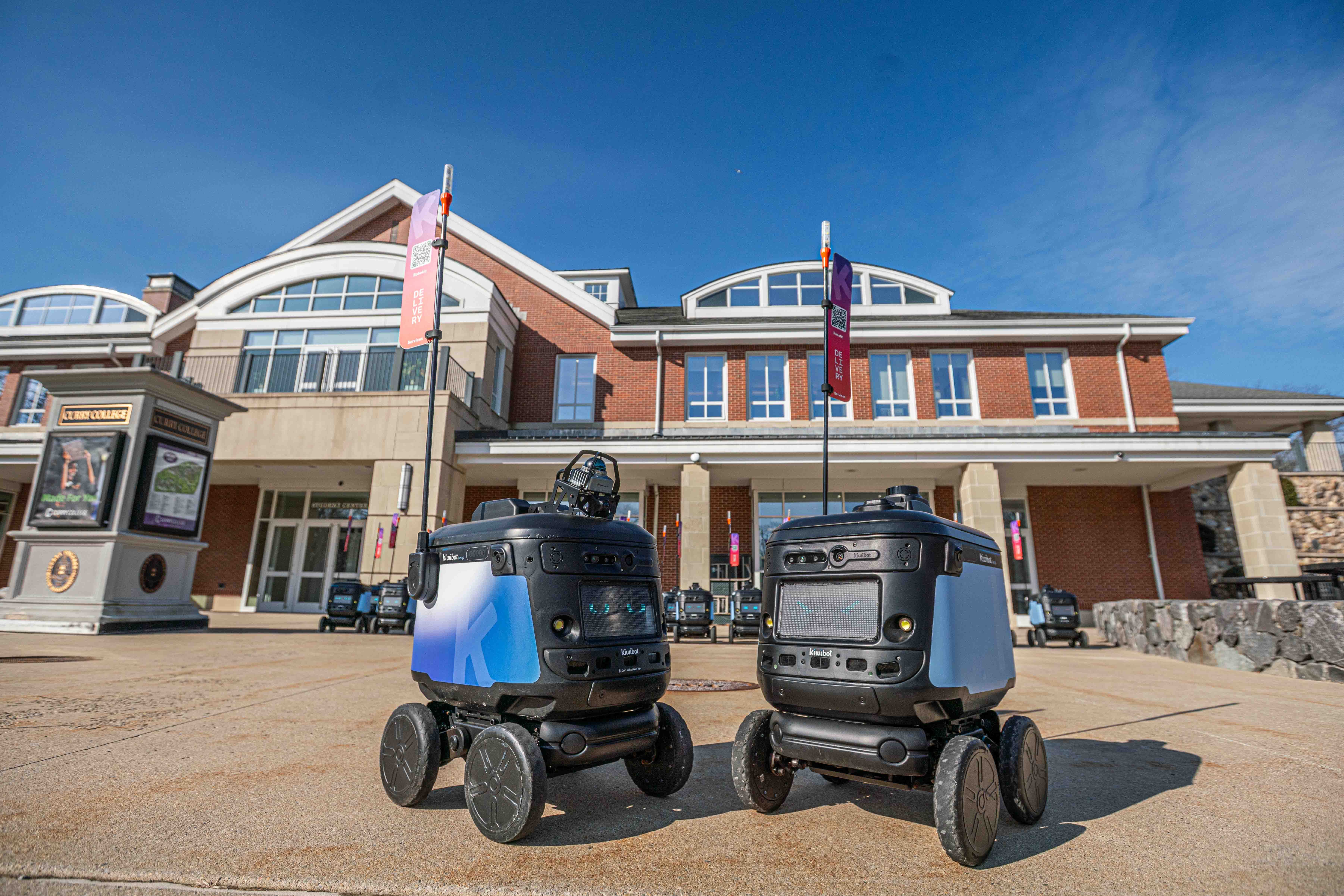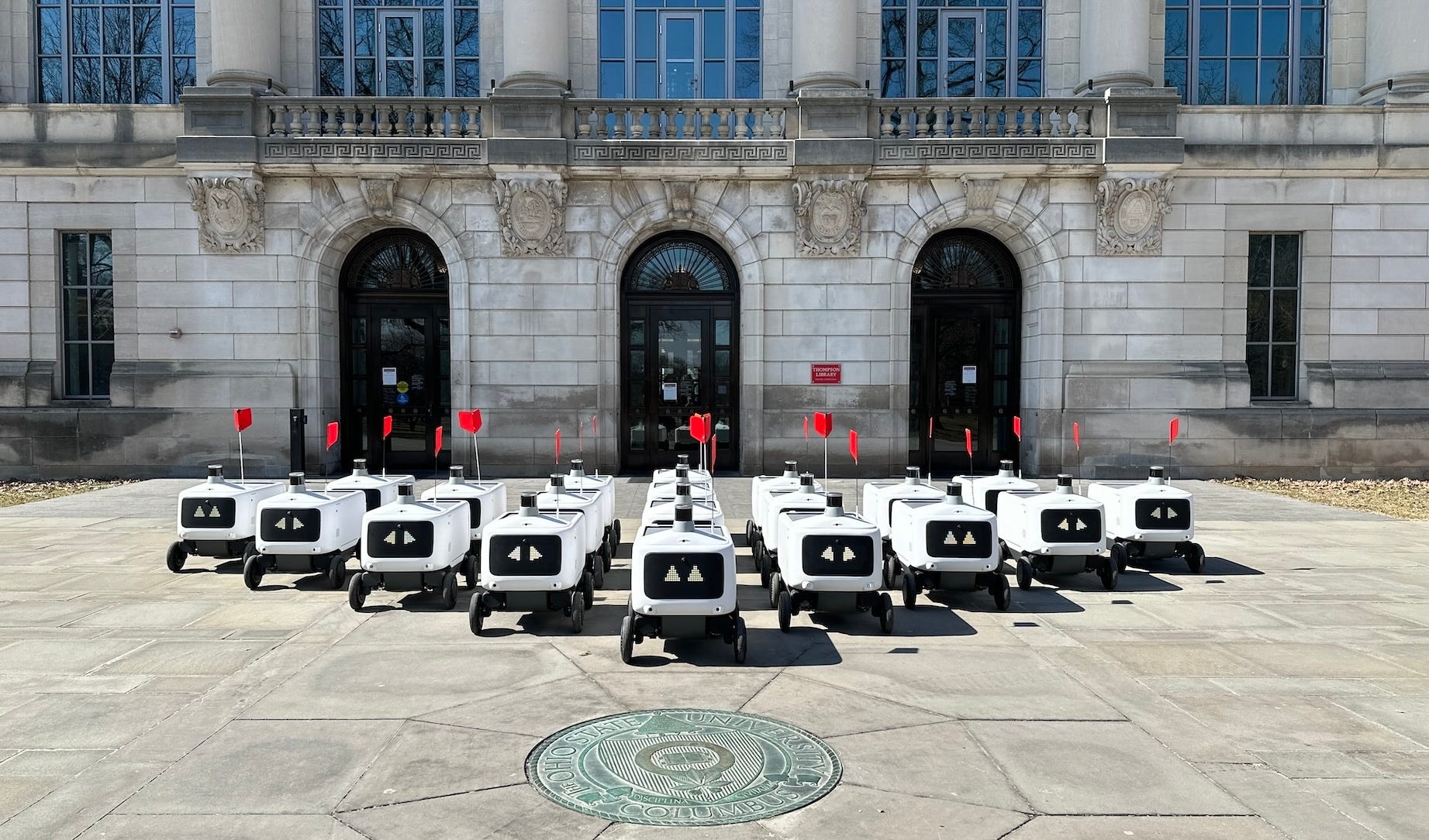
Starship
- Food delivery robots were once a novelty on college campuses. Now, they’re more common than ever.
- Starship leads the space, operating on 60 college campuses, along with Robot.com and Avride.
- As robot providers aim to take the delivery vehicles nationwide, college campuses may serve as a model.
Peyton Perry heard a rumor that delivery robots would be coming to campus when she was a student at Fairfield University.
Soon after, she saw her first robot at a campus Starbucks. She ordered food delivered by the robots multiple times during her junior year before her initial excitement wore off. By her senior year, she said, the robots had become a regular part of campus life.
“Every single day, I’d see multiple robots,” she told Business Insider. She said Starbucks and cafeteria workers were “constantly loading up the robots.”
A few years ago, food delivery robots were infamous for being kicked and vandalized by students on college campuses. Then the market matured, the robots got better, and the programs expanded to more colleges. Major university food providers, including Sodexo and Aramark, began partnering with the robot companies. By now, at least 78 American universities have delivery robots roaming their campuses, based on figures three leading robot providers shared with Business Insider.
Delivery robots have now extended far beyond colleges, as big companies like DoorDash enter the game. But universities offered an early testing ground for many of these companies, and could provide a model for nationwide expansion.
The college robotic delivery market is bigger — and more competitive — than ever before.
Starship leads the pack
If your kid is getting robot deliveries at school, there’s a good chance it’s from Starship.
Created by Skype cofounders Ahti Heinla and Janus Friis in 2014, Starship is the biggest campus provider, providing robot fleets to 60 universities. The company said it has over 2,000 robots deployed on campuses, delivering to 1.5 million students. It’s raised $230 million, and was valued at $151 million in its Series C round in 2024, according to PitchBook.
Starship said it’s turned a profit on each delivery for over three years.
“We have optimized costs a lot,” Heinla said, adding that bettering the technology means less money spent on repairs and maintenance. “We are now at the point where the unit economics work.”

Don Liebig/Don Liebig/ASUCLA
Starship has partnered with food delivery app Grubhub to grow. About half of the campuses Starship works with use its app, while the other half place orders through Grubhub. Starship isn’t Grubhub’s only partner; the food service app also works with Starship’s biggest direct competitor, Robot.com, and the rapidly growing Avride.
Over 40 of Grubhub’s campus partnerships now include robots. Steve Iarocci, senior director for Grubhub Campus, said some robots are better for city streets, and others are better for pedestrian-only campuses. “But, in general, it’s pretty ubiquitous technology at this point,” he said.
There’s no singular business model here. Contracts are signed between the robot companies and the food providers, though Grubhub sometimes functions as an intermediary. Some campuses pay monthly costs that are incorporated into students’ dining plans; others charge students a per-order delivery fee.
Robot.com and Avride race behind
While Starship is leading by its campus footprint, Robot.com is racing behind it. The company — formerly Kiwibot, as its robots are named — was founded in 2017 at UC Berkeley, and is now active on 16 campuses.
Cofounder and CEO Felipe Chavez said that the college campus has been “our sandbox.” The company is also expanding into major cities and golf courses.
Robot.com raised an estimated $33 million, according to PitchBook, though the company declined to comment on that figure and said it’s in the middle of a fundraising round. It also said its unit economics are positive, with an average gross margin of 40%.

Robot.com
Robot.com recently acquired an ad company and introduced robotic advertisements. Advertising makes up 35% to 40% of its revenue, Chavez said.
Behind Robot.com is Avride, a US-based startup spun out of the Russian company Yandex, which faced international sanctions after Russia invaded Ukraine. The publicly traded Nebius Group, Avride’s Dutch parent company, sold off Yandex’s Russia-based assets in 2024 while keeping some of its AI-focused businesses.
The company mainly operates on two college campuses, Ohio State University and the University of Arizona, where it has deployed 165 robots.
Chris Krnich, Avride’s business development manager, said that food providers saw the value in the robots when they began bringing in thousands of dollars a day.
Starship, Robot.com, and Avride have minor differences in tech. Starship said its robots are the most adaptive to different environments; Avride also makes robotaxis, and said that it shrunk the self-driving technology into their delivery bots. Much is the same, though. They all offer four-wheelers with cute eyes.
The challenges ahead
For Robot.com‘s Chavez, the industry’s real scaling point was when the “big three” university food providers — Sodexo, Aramark, and Compass — got on board with delivery bots.
Drew Nannis, Sodexo’s SVP and CMO of its campus segment, has watched robotic delivery grow since joining the company in 2019. He initially worried that robot deliveries would give students an excuse to hide in their rooms and not attend in-person dining. That hasn’t panned out, though.
“When the students are using them, they’re not replacing anything,” Nannis said. “They’re just supplementing and complementing.”

Avride
There are still bumps in the road. When Starship launched at Miami University in 2023, graduate Meredith Perkins noticed that the robots struggled to cross the street. The issue never fully went away, she said.
“So many students I know joke about the fact that these robots are very slow,” Perkins said.
Fairfield’s Perry once ordered coffee with her friend from the Starbucks across campus. They watched the robot stop moving on the tracking map and went out to find it. The robot was stuck on the curb.
“We found the robot, helped it up, but it was programmed, of course, so we had to follow it back to my friend’s apartment,” she said. “As we opened it, the coffee spilled all over it.”
Then there’s the question of payment. The average Starship delivery fee is $2.49 — less than a human courier’s, but still a tough sum for some college students to stomach. Perkins said that Miami University’s $2 delivery fee kept most students from using the robots.
Sodexo’s Nannis said that, when an additional charge was added per robotic delivery, usage fell drastically.
“The subscription model is the one that works,” Nannis said. “Making them part of the meal plans that we’re selling, I think that’s the most important piece of how we’re making this work financially.”
Who’s actually using the robots?
While delivery robots are expanding to more and more campuses, they’re still niche.
At UNC Charlotte, the robots opened up a whole new 9 p.m. to 2 a.m. dining period, said Ben Kolnos, Chartwells Higher Education’s senior retail director. Kolnos estimated that late-night orders made up 15 to 20% of UNC Charlotte’s 40,000 deliveries a semester. That’s not a high volume for a campus with 24,868 undergraduate students.
Students mainly use them when they’re sick, hungover, or holed up in the library studying. They’re not coming close to replacing the dining hall experience.
But with 200 deliveries a day at UNC Charlotte, the college campus may serve as a model for other companies looking to expand nationwide.
“People used to think of this technology five years ago as futuristic, or that companies were piloting something,” Starship’s Heinla said. “We’re not testing anything anymore. We’re not piloting anything anymore. We know that it works.”
Read the original article on Business Insider
The post The robots are coming: How food delivery bots are conquering college campuses appeared first on Business Insider.




